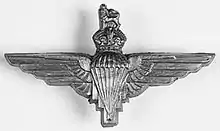1st Battalion, Parachute Regiment
The 1st Battalion, Parachute Regiment (1 PARA), is a battalion of the British Army's Parachute Regiment. Along with various other regiments and corps from across the British Armed Forces, it is part of Special Forces Support Group.
| 1st Battalion, Parachute Regiment | |
|---|---|
 Cap badge of the Parachute Regiment | |
| Active | 1941–1948 1948–Present |
| Country | |
| Branch | |
| Type | Airborne infantry |
| Role | Special operations support |
| Size | One battalion |
| Part of | Special Forces Support Group[1] |
| Nickname(s) | Sporting First |
| Motto(s) | Utrinque Paratus (Latin for "ready for anything") |
| Insignia | |
| Drop zone flash |  |
A specialized airborne light infantry unit, the battalion as of 2006 has been the main contributor of manpower to the British Army's Parachute Regiment and is capable of a wide range of operations. Personnel regularly deploy outside the United Kingdom on operations and training, 1 PARA is part of Special Forces Support Group and regarded as the elite of the Parachute Regiment deployed to assist United Kingdom Special Forces in a supporting role as well as being the main part of the hunter force on SF selection.[1]
All personnel complete the Pre Parachute Selection (P Company) course at the Infantry Training Centre Catterick Garrison, North Yorkshire (previously at Aldershot, Hampshire).
History

The 1st Battalion can trace its origins to 1940, when No. 2 Commando trained as parachutists. In 1941, the battalion was assigned to the 1st Parachute Brigade which also included the 2nd and 3rd battalions. The 1st Parachute Brigade was part of the 1st Airborne Division and remained with it throughout the war.
The battalion took part in operations in Tunisia in late 1942 to May 1943, suffering heavy casualties. The battalion and the brigade took part in Operation Fustian, when the Allies invaded Sicily and, again, suffered heavy casualties and was withdrawn to England in late 1943 to train and prepare for the Allied invasion of France. The battalion wasn't used in the initial invasion on 6 June 1944, D-Day, but was held back in the UK in reserve in case any of the five invasion beaches encountered serious difficulties and needed support. The plan turned out not to be required. During the fighting in Normandy numerous plans to drop the 1st Airborne were formed, none of which came to fruition. Finally, in September 1944, the battalion dropped into Arnhem the Netherlands with the rest of the 1st Airborne Division, as part of Operation Market Garden, where they suffered extremely heavy casualties and never saw combat again for the rest of the war.
After the war the battalion was reconstituted in 1946, and affiliated to the Brigade of Guards and served with the 6th Airborne Division in Palestine. It was disbanded in 1948, only to be reformed by the renumbering of the 4th/6th Battalion. The battalion was part of Operation Musketeer in 1956.
In the 1970s, the battalion first deployed to Northern Ireland in Operation Banner. The battalion was involved in the Ballymurphy Massacre[2] in August 1971, when 11 Catholic civilians were shot dead and many wounded over a two-day period. In January 1972, both the press and some in the Army accused the battalion of brutality against protesters outside Magilligan internment camp.[3][4] A week later, on 30 January 1972, the battalion carried out the Bloody Sunday killings, when they opened fire on unarmed protesters in Derry, leaving 14 Catholic civilians dead and 13 wounded; the greatest killing of British subjects by government forces in one incident since the Irish War of Independence.[5] The second official inquiry of the killings found 1st Para's actions "unjustified and unjustifiable".[6] To date, none of the members of 1 Para have been prosecuted. The battalion was involved in another controversial shooting incident on 7 September 1972, when soldiers shot dead two Protestant civilians and wounded others in the Shankill area of Belfast. A unit of the Army's Ulster Defence Regiment (UDR) refused to carry out duties until the battalion was withdrawn from the Shankill.[7]
The battalion was involved in the NATO operation in Kosovo in 1999, Operation Agricola.[8] In 2003, they were deployed to the Persian Gulf for Operation Telic in Iraq where despite overwhelming odds, two multiples of No. 8 platoon managed to fight their way out of the town of Majar al-Kabir. The battle took place in June 2003, in the post-invasion period of the Iraq War. During the battle, six Royal Military Policeman of 156 Provost Company were killed by an angry mob.[9]
See also
References
- "Parachute Regiment". www.army.mod.uk. Retrieved 19 April 2020.
- McCann, Eamonn (30 January 2014). "Bloody Sunday Revisited". CounterPunch. Retrieved 22 December 2017.
- Report of the Bloody Sunday Inquiry, Volume I, Chapter 9, paragraphs 202–221
- 'Bloody Sunday', 30 January 1972 – A Chronology of Events. Conflict Archive on the Internet (CAIN).
- "PMs Statement". Bloody Sunday Inquiry. 29 January 1998. Archived from the original on 21 April 2003.
- "Bloody Sunday Report Released - Bloody Sunday Killings Called 'Unjustified and Unjustifiable'". Gather.com. 15 June 2010. Archived from the original on 29 October 2013. Retrieved 15 July 2010.
- Wood, Ian S. Crimes of Loyalty: A History of the UDA. Edinburgh University Press, 2006. pp.104-105
- "The Parachute Regiment - Kosovo 1999". Eliteukforces.info. Retrieved 14 December 2019.
- Blair, David (26 June 2003). "Last stand at Majar al-Kabir". The Daily Telegraph. Retrieved 4 August 2017.